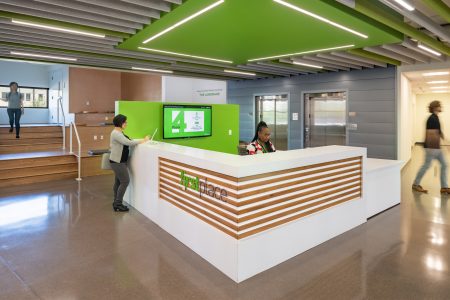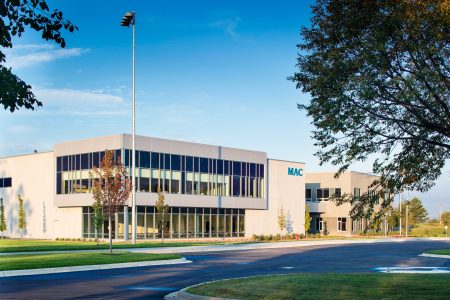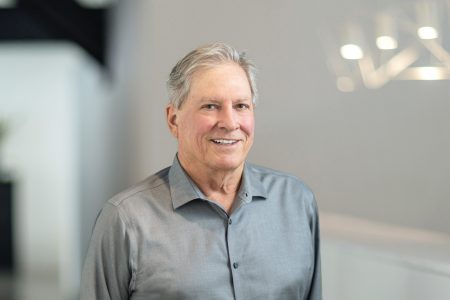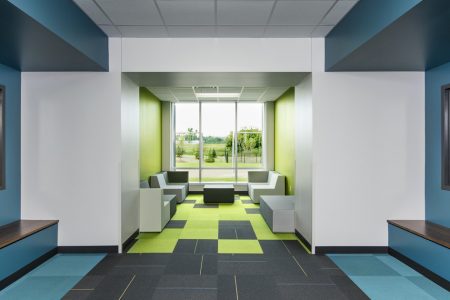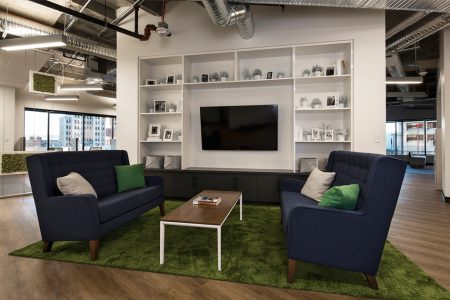Autism-aware design

By Thomas Denhardt, ArchitectureNow Jul 2017
Autism Spectrum Disorder (or ASD) is a misunderstood condition that affects an estimated 1 in 66 people, approximately 65,000 New Zealanders, yet it is absent in our accessibility codes. So how can architects and designers significantly improve the lives of those who are diagnosed with ASD? Thomas Denhardt talks with experts in the field.
In 1973, Louis Kahn was engaged to design Four Freedoms Park, a memorial that commemorates President Franklin D. Roosevelt’s life and his seminal Four Freedoms speech. Ironically, the sunken terrace incorporated into the design inhibited Roosevelt from the freedom to enjoy the memorial, since it is not wheelchair accessible. In Kahn’s defence, this was before the advent of the American Disabilities Act 1990. Some would say ignorance is bliss.
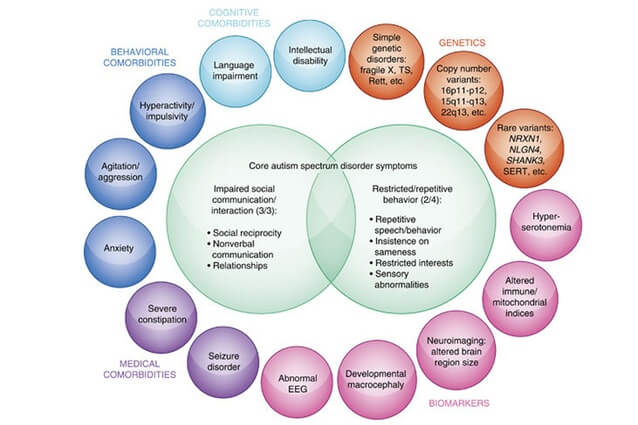
Since those times, accessibility has been amalgamated into new public proposals by architects, with the local Building Act stipulating NZS 4121 Access and Mobility – Buildings and Associated Facilities as a suitable standard. This egalitarian movement, driven by legislation, has given those with a disability an equal opportunity to participate and conduct their business independently within our built environment.
But what can architects do to contribute to the physical independence and inclusion of those who live with ASD? Ambiguous to many, misinterpreted by some and absent in accessibility codes, architects and designers can, through design, play a remarkably positive, influential hand in the lives of those who live with ASD. Exploring suitable design guidelines and examining a prime architectural case study that is considerate of ASD occupants will help to answer this question, with the potential of expanding further what is meant by architecture that is accessible for all. But firstly – what exactly is ASD?
Dr Javier Virués-Ortega, a New Zealand-registered clinical psychologist and director of Applied Behavioural Therapy at the University of Auckland, defines ASD. He describes classic symptoms that differ from those of people who are neurotypical (without ASD), and suggests where architecture can make a considerable difference. In its purest form, ASD is “a collection of dimensions that are highly variable across individuals,” states Virués-Ortega. These dimensions can be characterised as excesses and deficits.
Using human behaviour as an example, “a behavioural excess is something that a person with ASD is doing more often than a person without the diagnosis,” he adds, such as having a close affinity to numbers or arranging items in a particular order. On the other hand, “a behavioural deficit is something that the person is doing less often than expected,” such as avoiding social interactions and physical contact with others.
Briefly, the classic symptoms of those with ASD can be clustered around three constituents: impaired social interaction, impaired communication and restricted behaviour. Impaired social interaction is “a lack of social referencing, where the ability to interpret gestural cues provided by a peer or caregiver is not fully developed,” explains Virués-Ortega. Impaired communication can be quite diverse, with individuals of low-functioning autism often failing to develop spoken language whereas others display a limited verbal repertoire comprised of non-functional repetitive words or phrases (echolalia).
Lastly, and most substantially to architects, is the classic symptom of restricted behaviour. This is where individuals exhibit repetitive, stereotypic or ritualistic patterns of behaviour, which can be very diverse and classified as highly idiosyncratic. For example, a middle-aged man may be a serial organiser and insist on having things in a certain way, including being highly susceptible to outside noises.
Sensory processing problems – such as auditory issues established in the example above (including tactile, olfactory and visual dysfunction), agoraphobia and difficulty transitioning through spaces or changing routines – are some of the key challenges faced by individuals with ASD who have restricted behaviour.
These challenges are the primary focus for architects and designers to consider when designing private and public environments, such as multi-storeyed city apartments and local shopping malls. “This is the space in which design and architecture can make a significant difference,” Virués-Ortega suggests, since the way we design our built environment can heighten or lessen these challenges for ASD individuals, thus heightening or lessening the likelihood of their challenging behaviours.
This ‘significant difference’ that architectural design can conduce for those with ASD can be perceived as a foreign concept to most practitioners – esoteric, even. Dr Magda Mostafa, a special needs design associate and architect at Progressive Architects, as well as the associate chair of the Department of Architecture at the American University in Cairo, explains her groundbreaking Autism ASPECTSS Design Index, which establishes how implementing autism-aware design can be beneficial to all.
Trademarked in 2013 and developed over a decade of research, the index is “a framework made up of seven criteria, which form the acronym ASPECTSS: acoustics, spatial sequencing, escape space, compartmentalisation, transition space, sensory zoning and safety,” Dr Mostafa states. This index is non-prescriptive, unlike other accessibility codes, providing a spectrum of solutions that are applicable and helpful to all users on the spectrum. Being aware of the sensory input you are creating through your design decisions is strongly advocated in the ASPECTSS index, thus making the designer or architect mindful of the impact that input will have on the end users with ASD.
When applying ASPECTSS, one of the core facilitative concepts must be allowing for flexibility, growth and response to the development of skill and adaptation of its users, since individuals can have a diversity of needs, profiles and challenges. With this in mind, Dr Mostafa explains in more detail two of the seven criteria – acoustics and escape space.
Acoustics or auditory sensitivities are an acute challenge for many autistic individuals. However, implementing complete sound-proofing and full acoustical control is considered “counter-productive for the school or at home,” Dr Mostafa explains. This is due to the risk of the individual’s behaviour becoming accustomed to the environment, “only to have the individual unable to generalise that skill outside of this perfect space”. It is called ‘the greenhouse effect’ and is not sustainable in achieving the long-term objective of inclusion and independence. What is more effective in this regard is the implementation of acoustical management, where different levels of control provide for different levels of sensitivities for the users on the spectrum.
For instance, when Dr Mostafa consults (for schools, in particular), she suggests the “use of graduated acoustical control, where more controlled acoustics are applied to ‘low stimulus’ zones – such as libraries, and speech and language therapy rooms – especially for more sensitive users such as minors, who have not yet developed sensory management and integration skills.” This methodology allows children to develop skill and then graduate towards less acoustical control, as acoustic sensitivities becomes less obtrusive, especially with age.
On the other hand, escape space, unlike acoustics, is a principle that is readily applicable universally and capable of being implemented to different degrees in its own spectrum of manifestations. “These can range from a visually, acoustically and spatially separate space, like a small quiet room or a quiet bench under a tree in the garden of a school, to a simple quiet chair in a nook of a break room at an office, or a reading carrel in a library at a school,” Dr Mostafa says.
These escape spaces have the ability in creating an opportunity to remove oneself from experiences that are distracting and over-stimulating, or whenever a need to ‘re-adjust’, decompress and regain self-control arises. Dr Mostafa applied this principle recently for a group in the United States, where “one of the first recommendations I shared with them – particularly for those with existing premises and limited means to retrofit – was to provide the means for an escape space,” since it does not encumber the design or complicate the process while achieving the aim of inclusivity for those with ASD.
Furthermore, employing autism-aware design in architecture goes beyond the call of duty for those with ASD by being beneficial to those who are neurotypicals also. This is supported through Dr Mostafa’s research, where, in one case study, teachers as well as students gained indirectly from an improved acoustical environment. This is because “students focused better in a less stimulating environment, thus performing better academically, so teachers performed their jobs better, and so on, in a cycle of improvement”.
The same result was found for escape spaces, where everyone occasionally needs a moment of escape or a ‘sensory break’ from clockwork, with the provision of space to do so allowing for this management. From this, Dr Mostafa believes autism-aware design is helpful to the entire spectrum of human perception “provided flexibility is taken into consideration”.
CASE STUDY 1: FIRST PLACE APARTMENTS
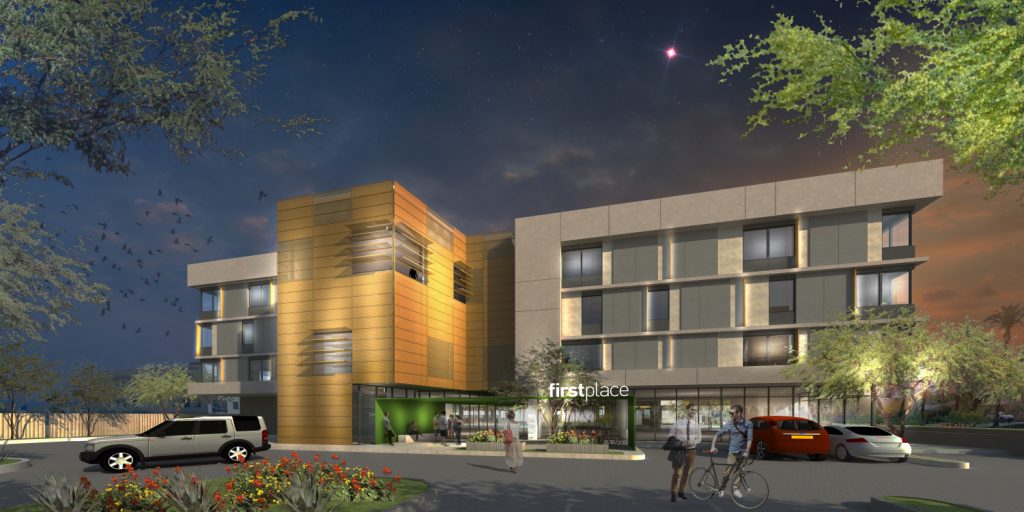
This concept of helpfulness that promotes physical independence is a ringing theme in the autism design world, since ASD individuals (specifically adults) transitioning from their secure family homes into greater society can be quite a challenging, even daunting, prospect.
Mike Duffy, associate and project design architect for RSP Architects in the US, discussed his benchmark proposal for clients, ‘First Place AZ’, which aids this transitioning process and the development of independence through architectural design, shedding light on lessons that were learnt in the process. First Place AZ is an independent not-for-profit organisation for individuals with autism and other neuro-diversities, which engaged RSP Architects to develop their exciting novel vision to fulfil the needs of those with ASD. Situated in Phoenix, the proposal comprises three major components:
- First Place Apartments – 56 studio, one, two and four-bedroomed units for lease, with independent living services and amenities;
- First Place Transition Academy operated by the Southwest Autism Research & Resource Center (SARRC), where 32 students, who are transitioning to more independent living, will experience paid internships and engage in volunteer activities each year, exposing them to different types of jobs while building their skills and resumés (with 16 residing in four four-bedroomed suites at First Place in year one of the two-year programme, and 16 living off-campus in year two);
- The First Place Leadership Institute is focused on continued education and training of support service providers, professionals and physicians, including a hub for research and public policy advancements.
The First Place Apartments are housed from the ground floor through to level four, while the First Place Leadership Institute and Transition Academy is organised around a central courtyard on the ground floor that provides security and facilitates various functions, including a community garden and pool amenities.
These components are the building blocks for the First Place mission, yet it is the intermittent spaces that are considered the glue that holds the bigger pieces together. Duffy explains this further, making reference to Kintsugi: “Kintsugi is the Japanese art of ‘golden repair’, where broken pieces of pottery are mended using resins made from precious metals, such as gold or silver. That which holds it together becomes more important, more special than the pieces it is holding together, with the circulation spaces at First Place Phoenix being treated as the golden resin.
This approach to design unifies the building programme, while creating a venue for social connections and networks that will form the support systems that make independence possible; this is considered vital to a successful transition to independent living. “Spontaneous conversations after classes, interaction with fellow neighbours, even individuals getting together to learn new culinary skills or enjoy a movie” are the types of unpredictable behaviour fostered in these circulation spaces, explains Duffy. Visible externally via yellow/gold metal panels, their symbolic importance is highlighted.
Internally, a plethora of measures are applied to achieve a hospitable environment that is considerate towards ASD individuals. “A refined and repeated material palette is strategically placed throughout to increase familiarity with spaces, with subtly coloured visual paths and signage employed to assist individuals in transitioning through spaces,” Duffy says. Designers in this regard are recommended to specify more muted colours like light blues, greens, tans, greys, even lavender, which promote calmness, rather than bright punchy colours that can overwhelm and exacerbate hypersensitivities.
Increased durability in materials is another measure applied throughout, including “acoustic baffles and inset entries for each apartment, which limits noise transfer”. Diffused LED lighting, which is less harsh, and ample natural lighting with strategically placed windows and doors provide comfort and illumination throughout the design, with operable windows providing the auxiliary benefit of controlled access to fresh air and passive ventilation.
In terms of safety and security, “a single point of entry with 24-hour ‘concierge’ services is provided,” Duffy says, with individuals having different locking options available to apartments to promote greater independence. Lastly, natural materials that are chemical free or have low toxicity levels (no VOCs) were also considered when specifying paints, sealants, plastics, adhesives and carpets.
Engaging with First Place AZ and their mission to support those with ASD has allowed RSP Architects to reach new meanings in the work they do, finding that “designing for those with ASD is not that different from designing for those without ASD”, but rather analogous. Every sensitivity on the autism spectrum has not been directly addressed Duffy confirmed, but through collective “discussions, dialogues and design charrettes, we’ve decided as a team what would be best to implement for First Place Phoenix given its mission”.
This process also influenced their response in implementing a more “neurotypical approach to design measures throughout”, knowing that someone’s next place may not have the same sensory sensitive design and approach. Individuals with ASD will “learn, grow, thrive and succeed” at First Place AZ, which has led to the autism community becoming beneficiaries of new knowledge, creativity and, most profoundly, as illustrated here, greater future independence.
It is commonly accepted today that, through architecture, architects and designers have a professional responsibility to envision and portray building design that is considerate of its users and inclusive of our diverse society. This responsibility includes ASD individuals. Characterised as excesses and deficits, ASD can be aggravated or lessened through our planning and design decisions, with numerous instruments available that work with the challenges of ASD individuals, not against them.
When researched and considered carefully, autism-aware design has the ability to transform architecture into a public message that redefines what accessible design means, which is demonstrated by Dr Magda Mostafa Autism ASPECTSS™ Design Index and First Place AZ’s audacious objective of physical independence.
We do not expect to live and work in leaky or unhealthy buildings, so we should not expect ASD individuals to live and work in buildings that hinder their independence or do not provide the capacity for them to fulfil their everyday needs. Architects and designers do not need to train nor recruit autism followers who paint the city in a coat of autism-alertness. Instead, they simply need to know what autism-aware design is and, in doing so, they will be consciously designing with everyone in mind.
So, rather than repeat history in the name of Louis Kahn, next time, when the project requires accessible means, ask yourself the question: where is the autism-aware design?
CASE STUDY 2: ‘THE MISSING LINK – DESIGNING FOR OPTIMAL HEALTH’; THESIS BY KAREN GOEDEKE

Last year, Karen Goedeke, a master’s student at the University of Auckland’s School of Architecture & Planning, completed her thesis research on the architecture of learning environments for children with ASD. Architecture New Zealand interviewed Goedeke about her investigations.
What made you interested in design for children with ASD? My interest in designing for ASD came from my passion for health and a growing awareness about environmental toxicity. With an undeniable relationship between the human body and its environment, society is getting sicker and our built environment is largely to blame. ASD gives clear symptoms that I could relay this knowledge back to, finding solutions to ease the overload of a surrounding building. My thesis presents a journey towards a symbiotic relationship between behaviour, environment and architecture, creating a school that stimulates those fleeting moments of calm where children can communicate, respond, learn and interact, and have them last a little bit longer.
Why is it important for architects to understand ASD? On the cusp of a demographic boom, it’s important for architects to truly understand the experience of those who are most sensitive to their surroundings. Rising levels of autism in children brings social anxiety, isolation and difficulty integrating into normal schooling situations. The built environment can be overwhelming, alienating and difficult to negotiate. The sooner architects understand and implement a change in the spaces around us, the best chance we have to protect developing and vulnerable immune systems, shaping future generations.
How did you conduct your research? I took a very hands-on approach in attending training that could further extend my own future practical application. Having spent time with staff and students at Wilson School in Auckland, I trained in geopathic stress testing (dowsing), assessment and shielding of electromagnetic radiation, and the fundamentals of building biology. The design has been developed by combining architectural application with involved research into the medical field, along with an understanding of ancient wisdom and applying this knowledge to a modern-day epidemic.
What are some of the observations you made? The most valuable observation I took away from this was not only how architecture can impact those with hypersensitivity but how basic understanding of natural radiation, man-made radiation and the impact of material specification can reduce the load on our already overloaded immune systems, drastically impacting the health of anyone.
What are some of the key outcomes? The most important thing we can do to design for autism and improve health is a combination of awareness, inclusion and exclusion. – Step one is to remove the cause. Electromagnetic radiation, geopathic stress and material toxicity make up an environmental load that impacts the body, behaviour and response to an environment. –
Step two is to provide an uplifting community to support and nurture spiritually, emotionally, physically and mentally. More than just providing sensory stimulation through sensory rooms and gardens, it’s about addressing the cellular level complications of autism to understand an environment and to reduce the symptoms.
Through sustainability and selective material choice, in line with building biology, implementing a ‘back-to-basics’ approach to reduce the chemical load emitted by materials. My project was broken into eight spaces that each worked to minimise or nurture one or more symptom of autism.
What’s the next step on your quest? I’ve only just begun! Since completing my thesis, I’ve continued to dowse houses of people with chronic illness in addition to those wanting to take preventative measures for the health of their families. Looking to the future, the principles that have been established are ones that will be carried through my architecture career, where the health of those occupying a space is my priority.

